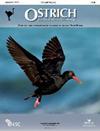Community involvement in the mass capture of Red-billed Queleas Quelea quelea adjacent to protected areas: the case of Chemba District, Dodoma, Tanzania
IF 1.1
4区 生物学
Q2 ORNITHOLOGY
引用次数: 0
Abstract
AbstractThe mass capture and utilisation of Red-billed Queleas Quelea quelea as a source of food is practiced in different African countries. The current study sought information on the trapping methods and techniques used by local communities in Chemba District, Tanzania, taking into account the respondents’ age, gender and occupation. It also captured the economic contributions and challenges associated with trapping queleas across the three study villages. Semi-structured questionnaires, focus group discussions and direct observations were used. Male respondents and adult farmers were found to participate most in quelea trapping. Queleas were used both as a source of food and income. Both a modern method (i.e. mist-netting) and traditional local trapping methods (e.g. grass basket traps and sticky tree resin) were reported to be used, but the combination of the modern and local methods was the most effective. Reported challenges included poor trapping techniques, scarcity of markets, and chemical spraying as a quelea control measure. Based on the results, we recommend detailed research on improving mass-trapping techniques and developing a marketing strategy to promote sales of the captured birds. As a long-term measure, these will contribute to improve both the livelihoods of local people and the ecological health of the communities.Implication des communautés dans la capture massive du travailleur à bec rouge Quelea quelea à proximité de zones protégées: le cas du district de Chemba, Dodoma, TanzanieLa capture massive et l’utilisation du Travailleur à bec rouge Quelea quelea comme source de nourriture sont pratiquées dans différents pays africains. La présente étude a cherché à obtenir des informations sur les méthodes et techniques de capture utilisées par les communautés locales du district de Chemba, en Tanzanie, en tenant compte de l’âge, du gendre et de la profession des personnes interrogées. Elle s’est également intéressée aux contributions économiques et aux défis associés au piégeage des Quelea quelea dans les villages étudiés. Des questionnaires semi-structurés, des discussions de groupe ciblées et des observations directes ont été utilisés. Les personnes interrogées de genre masculin et les agriculteurs adultes excellent dans le piégeage de l’éspèce. Les Travailleurs à bec rouge sont utilisés comme source de nourriture et de revenus. Différentes méthodes de piégeage ont été utilisées, mais c’est la combinaison de plusieurs méthodes qui est la plus efficace. Parmi les difficultés signalées, citons des mauvaises techniques de piégeage, la rareté des marchés où écouler les oiseaux capturés et la pulvérisation de produits chimiques comme mesure de contrôle de l’espèce. L’étude recommande une recherche détaillée sur l’amélioration des techniques de piégeage et le développement de stratégies de marketing pour promouvoir la vente commerciale de ces oiseaux. Ces mesures à long terme contribueront à améliorer les moyens de subsistance des communautés et l’intégrité écologique du district de Chemba.Keywords: East Africaecological integrityeconomic sustainabilitylivelihoodspest controlquelea trappingRed-billed Weavertrapping techniques社区参与大规模捕获保护区附近的红嘴Queleas Quelea Quelea:坦桑尼亚多多马Chemba区的案例
摘要在非洲不同国家,大量捕获和利用红嘴鱼作为一种食物来源。目前的研究在考虑到应答者的年龄、性别和职业的情况下,寻求关于坦桑尼亚Chemba地区当地社区使用的诱捕方法和技术的信息。它还记录了与在三个研究村庄捕获奎利亚斯有关的经济贡献和挑战。采用半结构化问卷调查、焦点小组讨论和直接观察。男性回答者和成年农民参与奎莱诱捕最多。奎利亚被用作食物和收入的来源。据报告,现代方法(如雾网)和传统的本地捕集方法(如草篮捕集器和粘树树脂)都被使用,但现代和本地方法相结合是最有效的。报告的挑战包括捕获技术差、市场稀缺以及作为羽衣虫控制措施的化学喷洒。在此基础上,我们建议对改进大规模捕鸟技术和制定营销策略进行详细的研究,以促进捕获的鸟类的销售。作为一项长期措施,这些措施将有助于改善当地人民的生计和社区的生态健康。含义:社区内的各种各样的 和其他所有的 与其他所有的 与其他所有的与其他所有的与其他所有的与其他所有的与其他所有的与其他所有的与其他所有的与其他所有的与其他所有的。在坦桑尼亚的Chemba区,在坦桑尼亚的社区,在坦桑尼亚的区域,在坦桑尼亚的区域,在坦桑尼亚的区域,在坦桑尼亚的区域,在坦桑尼亚的区域,在坦桑尼亚的区域,在坦桑尼亚的区域,在坦桑尼亚的区域,在坦桑尼亚的区域,在坦桑尼亚的区域,在坦桑尼亚的区域,在坦桑尼亚的区域,在坦桑尼亚的区域,在坦桑尼亚的区域,在坦桑尼亚的区域,在坦桑尼亚的区域,在坦桑尼亚的区域,在坦桑尼亚的区域,在坦桑尼亚的区域,在坦桑尼亚的区域,在坦桑尼亚的区域,在坦桑尼亚的区域,在坦桑尼亚的区域。最简单的薪金薪金表是由薪金薪金表、薪金薪金表、薪金薪金表、薪金薪金表、薪金薪金表和薪金薪金表组成。调查问卷是半结构的,讨论是群体的,观察是直接的,观察是直接的,使用是直接的。人的审问是男性的,农民的审问是男性的,优秀的人的审问是男性的。这是一种营养来源,也是一种收入来源。各种方法de piegeage永久使用,但是这就是combinaison de几个方法是拉加efficace。Parmi les。我recommande一个矫揉造作的detaillee苏尔L 'amelioration des技术de piegeage et le开发署德德营销策略倒promouvoir la出售commerciale de ces oiseaux。它衡量的是长期缴款者- - - - - - - - - - - - - - - - - - - - - - - - - - - - - - - - - - - - - - - - - - - - - - - - - - - - - - - - - - - - - - - - - - - - - - - - - - - - -关键词:东非;生态完整性;经济可持续性
本文章由计算机程序翻译,如有差异,请以英文原文为准。
求助全文
约1分钟内获得全文
求助全文
来源期刊

Ostrich
生物-鸟类学
CiteScore
2.10
自引率
30.00%
发文量
24
审稿时长
>12 weeks
期刊介绍:
Ostrich: Journal of African Ornithology is the leading ornithological journal in Africa, and publishes peer-reviewed scientific papers and short communications (
 求助内容:
求助内容: 应助结果提醒方式:
应助结果提醒方式:


